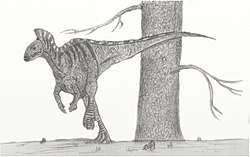Lourinhã Formation
The Lourinhã Formation (Portuguese pronunciation: [loɾiˈɲɐ̃] (![]()
| Lourinhã Formation Stratigraphic range: Kimmeridgian-Tithonian ~152–146 Ma | |
|---|---|
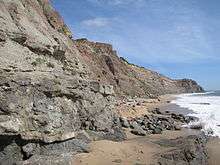 | |
| Type | Geological formation |
| Sub-units |
|
| Underlies | Porto da Calada Formation |
| Overlies | Consolação & Alcobaça Formations |
| Thickness | 200–1,100 metres (660–3,610 ft) |
| Lithology | |
| Primary | Sandstone, mudstone, marl |
| Other | Conglomerate, limestone |
| Location | |
| Region | Lisbon Region |
| Country | |
| Extent | Lusitanian Basin |
| Type section | |
| Named for | Lourinhã |
| Named by | Hill |
| Year defined | 1988 |
Besides the fossil bones, Lourinhã Formation is well known for the fossil tracks[2] and fossilized dinosaur eggs.[3]
The Lourinhã Formation includes several lithostratigraphic units, such as Praia da Amoreira-Porto Novo Members and the Sobral Unit.[4]
Lithology and depositional history
Depositional history

The Lourinhã Formation is located within the Lusitanian Basin, a mostly onshore North South orientated rift basin within western Portugal, formed during the Opening of the North Atlantic Ocean, with sediment deposition beginning during the Late Triassic-Early Jurassic. It primarily consists of syn-rift near-coastal continental siliciclastic sediments, with several marine intercalations. The primary flow direction was North to South, originating from Galicia and flowing between the Iberian landmass to the east and the now largely submerged Berlengas horst, a North-South oriented ridge, to the west.
Stratigraphy
The unit was first formally proposed by Hill in 1988.
The stratigraphy of the Lourinhã Formation is complex and varies between sub-basins with several competing stratigraphic proposals and there is currently no consensus on the matter, one of the most recent stratigraphies,[1] divides the formation into three members which are from oldest to youngest the Praia da Amoreira-Porto Novo Member, Praia Azul Member, and the Assenta Member.
Praia da Amoreira-Porto Novo Member
The Praia da Amoreira-Porto Novo Member is composed of the Priaia de Amoreira Member, which consists of massive mudrock-sand with metre thick sandstone lenses, with massive mudrock with calcrete. The overlying Poto Novo Mb. consists of massive bodies of sandstone, often cross bedded. The environment of deposition is interpreted as a meandering fluvial system, while the Porto Novo Mb is interpreted as a deltaic deposit. It is interpreted to be latest Kimmeridgian in age.
Praia Azul Member
The Praia Azul Member, formerly known as the Sobral unit/member is 80 to 130 metres thick and consists of tabular marls and mudstones, with rare sandstones bodies.There are three distinct laterally extensive (>20 km) thin shelly carbonate horizons within this member, indicating brief marine transgressions. South of Santa Cruz primarily consists of sandstone with rare conglomerate. The age is considered to be latest Kimmeridigan to earliest Tithonian.
Assenta Member
The Assenta Member is around 300 metres thick and predominantly consists of mudstones with frequent layers of caliche. Near the top of the member several layers of tens of metres thick nodular and marly bioclastic limestones are present, containing marine benthic forams, the nodularity is derived from intense Thalassinoides burrowing. It is predominately late Tithonian in age, with the last few metres probably being earliest Berriasian. The environment of deposition is interpreted as being an upper fluvial-dominated delta to meandering fluvial systems flowing on a paralic plain.
Dinosaurs of the Lourinhã Formation
In a 2003 study, an analysis of all Portuguese dinosaurs was published. The study created a cladogram showing the possible relations of all Portuguese dinosaurs, including those at the time known from the Lourinhã Formation.[5]
| Dinosauria |
| |||||||||||||||||||||||||||||||||||||||||||||||||||||||||||||||||||||||||||||||||||||||||||||||||||||||||||||||||||||||||||||||||||||||||||||
Saurichia
Theropods
| Genus | Species | Member | Material | Notes | Images |
|---|---|---|---|---|---|
| Abelisauridae indet.[6] | Intermediate[6] | Teeth; ML 966, Ml 327.[6] | Potentially diagnostic abelisaur teeth.[6] | ||
|
A. europaeus[7] |
Porto Novo Member[7] |
Two specimens, covering much of the body.[9] |
Potentially a synonym of the type species, A. fragilis. |
||
|
A. fragilis[8] |
Two specimens, covering much of the body.[9] |
Now thought to represent a distinct species of Allosaurus, A. europaeus.[7] |
 Allosaurus fragilis | ||
|
Potentially a synonym of the type species, C. nasicornis. Sometimes referred to as C. sp., giving indication of possible distinctiveness or of being intermediate.[12] |
| ||||
| Dendroolithidae[3] | Indeterminant | Fragments of multiple eggs in a clutch, with associated embryonic remains.[3] | Probably eggs of Torvosaurus.[3] | ||
|
Three individuals, one largely complete; over 100 eggs with significant amount of skeletal material.[13] |
Has come out in various places in the tree, erroneously said to be a megalosaur,[7] mostly accepted to be a carnosaur, probably allosauroid, or basal coelurosaur. Currently unstable on the tree.[13] |
 Embryo | |||
|
M. insignis[6] |
Teeth.[6] |
Invalid. Teeth belong to various other theropod taxa.[6] |
|||
|
M. pombali[6] |
Teeth.[6] |
Invalid. Teeth belong to various other theropod taxa[6] |
|||
|
M. sp.[6] |
Tooth fragment.[6] |
Invalid; Dubious.[6] |
|||
|
R. aff. gilmorei[6] |
Tooth; ML 939[6] |
Only definite record of this taxon is from the Late Cretaceous of North America, despite erroneous and referrals from other sites in Portugal. Probably a close relative of Richardoestesia and not an actual representation of the taxon.[6] |
|||
|
T. gurneyi[14] |
Maxilla, Teeth, Femur; Egg clutch and embryos.[3][7][14][15] |
Largest known European theropod. Previous known as Portugal populations of the type species, or as T. sp., before description in early 2014.[14] |
 Skeletal restoration showing the size of T. gurneyi, known remains highlighted. | ||
|
T. tanneri[14] |
Now described as a distinct species of Torvosaurus, T. gurneyi. Sometimes referred to as T. sp. in the past.[14] |
||||
Color key
|
Notes Uncertain or tentative taxa are in small text; |
Sauropods
| Genus | Species | Member | Material | Notes | Images |
|---|---|---|---|---|---|
|
One specimen. Vertebrae; potentially other parts of the body.[16][17] |
Junior synonym of Supersaurus. |
||||
|
Diplodocidae indet.[17] |
Intermediate[17] |
One Dorsal Vertebra[17] |
Regarded by Mannion et al. (2012) as being unique from Dinheirosaurus and possibly indicating another diplodocid in the formation, but being non-diagnostic it doesn't warrant description.[17] |
||
|
L. alenquerensis[18] |
|
||||
|
Fragmentary material.[19] |
A large brachiosaur, a close relative of Brachiosaurus proper.[19] |
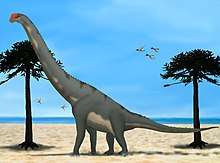 | |||
| Oceanotitan | O. dantasi[21] | Amoreira-Porta Novo Member | scapula, almost all of the pelvis, a complete leg sans the toes, and nine caudals. | A titanosauriform | |
| S. lourinhanensis[22] | Amoreira-Porta Novo Member[22] | One specimen. Vertebrae; potentially other parts of the body.[22] | Previously Dinheirosaurus. Tschopp et al. (2015) sunk the genus into Supersaurus.[22] | 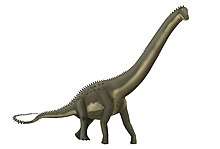 | |
| Zby[12] | Z. atlanticus[12] | Amoreira-Porto Novo Member[12] | Holotype: Tooth, cervical neutral arch, forelimb, various other fragments.[12] | No described close relatives from the Morrison Formation or Tendaguru beds; instead allied to other European taxa. Note however teeth from the Tendaguru beds might belong to Turiasauria, as Zby.[12] |  |
Ornithischia
| Genus | Species | Member | Material | Notes | Images |
|---|---|---|---|---|---|
|
T. cuneatus[5] |
Amoreira-Porto Novo Member[12] |
||||
|
A. kuehnei[5] |
|||||
Thyreophorans
| Genus | Species | Member | Material | Notes | Images |
|---|---|---|---|---|---|
|
D. armatus[23] |
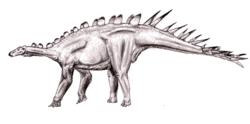 | ||||
|
D. brodricki[24] |
Eleven tracks; Nine pes and two manus prints.[24] |
The tracks can be separated into three different morphologies, though all fall within range of the taxon. Association of the pes and manus tracks to the same taxon cannot be directly supported. Preserve various well preserved skin impressions. Largest prints are larger than those from the type horizon. The tracks are individually represented and do not form any sort of trackway, thought one print is associated with giant ornithopod track,[25] potentially representing that the creatures were traveling together or were otherwise going to a similar location. Another is similarly associated with theropod and sauropod prints.[24] |
|||
| Dracopelta[5] | D. zbyszewskii[5] | ||||
| Miragaia[23] | M. longicollum[23] | Holotype, neck, partial skull, forelimbs, ribs. Tentative juvenile specimen assigned to this taxon.[23] | Stegosaur with unusually long neck of 17 cervicals, with more neck vertebrae than most sauropods.[23] | 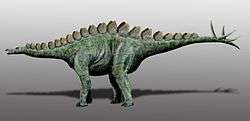 | |
| Stegosaurus[26] | S. cf. ungulatus | 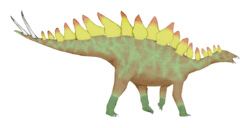 | |||
Ornithopods
| Genus | Species | Member | Material | Notes | Images |
|---|---|---|---|---|---|
|
Intermediate[27] |
Limb material.[27] |
Now referred to its own genus, Draconyx, along with some other material.[27] |
|||
|
D. loureiroi[27] |
Bombarral Member[27] |
Two specimens; holotype, relatively incomplete, and a femur.[27] |
|||
|
D. sp.[5] |
Sobral Unit |
||||
| Eousdryosaurus[28] | E. nanohallucis[28] | Praia da Amoreira-Porto Novo Formation[28] | |||
|
Ornithopoda indet.[25] |
Intermediate[25] |
Single track.[25] |
Gigantic track indicating an ornithopod with a hip height of 2.5 meters. No known Jurassic Ornithopod reaches this size; only known evidence for such sizes in this group at the time. Found alongside Deltapodus print.[25] |
||
|
P. henkelli.[5] |
|||||
Synapsids of the Lourinhã Formation
Docodonta
| Genus | Species | Member | Material | Notes |
|---|---|---|---|---|
|
Haldanodon expectatus |
Partial skeleton and isolated bones |
Semi-aquatic forager. | ||
Dryolestoidea
| Genus | Species | Member | Material | Notes |
|---|---|---|---|---|
|
Nanolestes drescherae |
Right lower molar. |
Amphitheriidae; small omnivore or insectiore. | ||
|
Guimarotodus |
Guimarotodus inflatus |
Right mandible. |
Dryolestidae; insectivore or omnivore. | |
|
Krebsotherium |
Krebsotherium lusitanicum |
Left mandible. |
Dryolestidae; insectivore or omnivore. | |
|
Drescheratherium acutum |
Upper jaw. |
Paurodontidae; herbivore. | ||
Flora
| Genus | Species | Member | Material | Notes | Images |
|---|---|---|---|---|---|
| Pterophyllum | P. mondeguensis | ||||
| P. sp. | |||||
| Sphenolepis | S. coffati | ||||
Correlation
| Ma | Age | Paleomap \ Basins | Cantabrian | Olanyà | Cameros | Maestrazgo | Oliete | Galve | Morella | South Iberian | Pre-betic | Lusitanian | ||
|---|---|---|---|---|---|---|---|---|---|---|---|---|---|---|
| 100 | Cenomanian |  | La Cabana | Sopeira | Utrillas | Mosquerela | Caranguejeira | |||||||
| Altamira | Utrillas | |||||||||||||
| Eguino | ||||||||||||||
| 125 | Albian | Ullaga - Balmaseda | Lluçà | Traiguera | ||||||||||
| Monte Grande | Escucha | Escucha | Jijona | |||||||||||
| Itxina - Miono | ||||||||||||||
| Aptian | Valmaseda - Tellamendi | Ol Gp. - Castrillo | Benassal | Benassal | Olhos | |||||||||
| Font | En Gp. - Leza | Morella/Oliete | Oliete | Villaroya | Morella | Capas Rojas | Almargem | |||||||
| Patrocinio - Ernaga | Senyús | En Gp. - Jubela | Forcall | Villaroya | Upper Bedoulian | Figueira | ||||||||
| Barremian | Vega de Pas | Cabó | Abejar | Xert | Alacón | Xert | Huérguina | Assises | ||||||
| Prada | Artoles | Collado | Moutonianum | Papo Seco | ||||||||||
| Rúbies | Tera Gp. - Golmayo | Alacón/Blesa | Blesa | Camarillas | Mirambel | |||||||||
| 150 | Hauterivian |  | Ur Gp. - Pinilla | Llacova | Castellar | Tera Gp. - Pinilla | Villares | Porto da Calada | ||||||
| hiatus | ||||||||||||||
| Huerva | Gaita | |||||||||||||
| Valanginian | Villaro | Ur Gp. - Larriba | Ped Gp. - Hortigüela | |||||||||||
| Ped Gp. - Hortigüela | Ped Gp. - Piedrahita | |||||||||||||
| Peñacoba | Galve | Miravetes | ||||||||||||
| Berriasian |  | Cab Gp. - Arcera | Valdeprado | hiatus | Alfambra | |||||||||
| TdL Gp. - Rupelo | Arzobispo | hiatus | Tollo | |||||||||||
| On Gp. - Huérteles Sierra Matute | ||||||||||||||
| Tithonian | Lastres | Tera Gp. - Magaña | Higuereles | Tera Gp. - Magaña | Lourinhã | |||||||||
| Arzobispo | ||||||||||||||
| Ágreda | ||||||||||||||
| Legend | Major fossiliferous, oofossiliferous, ichnofossiliferous, coproliferous, minor formation | |||||||||||||
| Sources | ||||||||||||||
See also
- Camadas de Alcobaça
- Camadas de Guimarota
- List of fossil sites
- Museu da Lourinhã
- List of dinosaur bearing rock formations
References
- Mateus, O.; Dinis, J.; Cunha, P. P. (2017-09-28). "The Lourinhã Formation: the Upper Jurassic to lower most Cretaceous of the Lusitanian Basin, Portugal – landscapes where dinosaurs walked". Ciências da Terra / Earth Sciences Journal. 19 (1): 75–97. doi:10.21695/cterra/esj.v19i1.355. ISSN 2183-4431.
- Milàn, J; Christiansen, P; Mateus, O. "A three-dimensionally preserved sauropod manus impression from the Upper Jurassic of Portugal: implications for sauropod manus shape and locomotor mechanics". Kaupia. 14: 47–52.
- Araújo, R., Castanhinha R., Martins R. M. S., Mateus O., Hendrickx C., Beckmann F., Schell N., & Alves L. C. (2013). "Filling the gaps of dinosaur eggshell phylogeny: Late Jurassic Theropod clutch with embryos from Portugal" (PDF). Scientific Reports. 3: 1924. Bibcode:2013NatSR...3E1924A. doi:10.1038/srep01924. PMC 3667465. PMID 23722524.CS1 maint: multiple names: authors list (link)
- Weishampel, David B. et al. (2004). "Dinosaur distribution (Late Jurassic, Europe)." In: Weishampel, David B.; Dodson, Peter; and Osmólska, Halszka (eds.): The Dinosauria, 2nd ed., Berkeley: University of California Press. pp. 545–549. ISBN 0-520-24209-2.
- Antunes, M.T.; Mateus, O. (2003). "Dinosaurs of Portugal" (PDF). Comptes Rendus Palevol. 2 (1): 77–95. doi:10.1016/S1631-0683(03)00003-4.
- Hendrickx, C., & Mateus O. (2014). "Abelisauridae (Dinosauria: Theropoda) from the Late Jurassic of Portugal and dentition-based phylogeny as a contribution for the identification of isolated theropod teeth". Zootaxa. 3759: 1–74. doi:10.11646/zootaxa.3759.1.1. PMID 24869965.CS1 maint: multiple names: authors list (link)
- Mateus, O., Walen A. and Antunes M. T. (2006). "The large theropod fauna of the Lourinhã Formation (Portugal) and its similarity to the Morrison Formation, with a description of a new species of Allosaurus". New Mexico Museum of Natural History and Science Bulletin. 36: 123–129.CS1 maint: multiple names: authors list (link)
- Malafaia, E.; Ortega, F.; Escaso, F.; Dantas, P.; Pimentel, N.; Gasulla, J. M.; Ribeiro, B.; Barriga, F.; Sanz, J. L. (2010-12-10). "Vertebrate fauna at the Allosaurus fossil-site of Andrés (Upper Jurassic), Pombal, Portugal". Journal of Iberian Geology. 36 (2): 193–204. doi:10.5209/rev_jige.2010.v36.n2.7.
- Allosauruseuropaeus. archosaur.us
- Mateus, O. and Antunes M. T. (2000). Ceratosaurus sp. (Dinosauria: Theropoda) in the Late Jurassic of Portugal. Abstract volume of the 31st International Geological Congress. Rio de Janeiro, Brazil
- Malafaia, Elisabete; Ortega, Francisco; Escaso, Fernando; Silva, Bruno (2015-10-03). "New evidence of Ceratosaurus (Dinosauria: Theropoda) from the Late Jurassic of the Lusitanian Basin, Portugal". Historical Biology. 27 (7): 938–946. doi:10.1080/08912963.2014.915820.
- Mateus, O., Mannion P. D., & Upchurch P. (2014). "Zby atlanticus, a new turiasaurian sauropod (Dinosauria, Eusauropoda) from the Late Jurassic of Portugal". Journal of Vertebrate Paleontology. 34 (3): 618–634. doi:10.1080/02724634.2013.822875.CS1 maint: multiple names: authors list (link)
- Lourinhanosaurusantunesi. archosaur.us
- Hendrickx, Christophe; Mateus, Octávio (2014). "Torvosaurus gurneyi n. sp., the Largest Terrestrial Predator from Europe, and a Proposed Terminology of the Maxilla Anatomy in Nonavian Theropods". PLoS ONE. 9 (3): e88905. Bibcode:2014PLoSO...988905H. doi:10.1371/journal.pone.0088905. PMC 3943790. PMID 24598585.
- Torvosaurusgurneyi. archosaur.us
- Bonaparte, J.; Mateus, O. (1999). "A New Diplodocid, Dinheirosaurus lourinhanensis gen. et sp. nov., from the Late Jurassic Beds of Portugal" (PDF). Revista del Museo Argentino de Ciencias Naturales. 5 (2): 13–29. ISSN 0524-9511. Archived from the original (PDF) on 2007-09-28.
- Mannion, P.D.; Upchurch, Paul; Mateus, O.; Barnes, R.N.; Jones, M.E.H. (2012). "New information on the anatomy and systematic position of Dinheirosaurus lourinhanensis (Sauropoda: Diplodocoidea) from the Late Jurassic of Portugal, with a review of European diplodocoids" (PDF). Journal of Systematic Palaeontology. 10 (3): 521–551. doi:10.1080/14772019.2011.595432.
- Mocho, Pedro; Royo-Torres, Rafael; Ortega, Francisco (2014-04-01). "Phylogenetic reassessment of Lourinhasaurus alenquerensis, a basal Macronaria (Sauropoda) from the Upper Jurassic of Portugal". Zoological Journal of the Linnean Society. 170 (4): 875–916. doi:10.1111/zoj.12113.
- Mannion, Philip D.; Upchurch, Paul; Barnes, Rosie N.; Mateus, Octávio (2013). "Osteology of the Late Jurassic Portuguese sauropod dinosaur Lusotitan atalaiensis (Macronaria) and the evolutionary history of basal titanosauriforms" (PDF). Zoological Journal of the Linnean Society. 168: 98–206. doi:10.1111/zoj.12029.
- Mocho, P.; Royo-Torres, R.; Ortega, F. (2016-11-03). "New data of the Portuguese brachiosaurid Lusotitan atalaiensis (Sobral Formation, Upper Jurassic)". Historical Biology. 0 (6): 789–817. doi:10.1080/08912963.2016.1247447. ISSN 0891-2963.
- Mocho, Pedro; Royo-Torres, Rafael; Ortega, Francisco (2019). "A new macronarian sauropod from the Upper Jurassic of Portugal". Journal of Vertebrate Paleontology. e1578782: e1578782. doi:10.1080/02724634.2019.1578782.
- Tschopp, E.; Mateus, O. V.; Benson, R. B. J. (2015). "A specimen-level phylogenetic analysis and taxonomic revision of Diplodocidae (Dinosauria, Sauropoda)". PeerJ. 3: e857. doi:10.7717/peerj.857. PMC 4393826. PMID 25870766.

- Mateus, O., Maidment S., & Christiansen N. (2009). "A new long-necked 'sauropod-mimic' stegosaur and the evolution of the plated dinosaurs". Proceedings of the Royal Society B: Biological Sciences. 276 (1663): 1815–21. doi:10.1098/rspb.2008.1909. PMC 2674496. PMID 19324778.CS1 maint: multiple names: authors list (link)
- Mateus, O., Milàn J., Romano M., & Whyte M. A. (2011). "New finds of stegosaur tracks from the Upper Jurassic Lourinhã Formation, Portugal". Acta Palaeontologica Polonica. 56 (3): 651–658. doi:10.4202/app.2009.0055.CS1 maint: multiple names: authors list (link)
- Mateus, O., & Milan J. (2008). "Ichnological evidence for giant ornithopod dinosaurs in the Upper Jurassic Lourinhã Formation, Portugal". Oryctos. 8: 47–52.CS1 maint: multiple names: authors list (link)
- Escaso, Fernando; Ortega, Francisco; Dantas, Pedro; Malafaia, Elisabete; Pimentel, Nuno L.; Pereda-Suberbiola, Xabier; Sanz, José Luis; Kullberg, José Carlos; Kullberg, María Carla (2006-12-23). "New evidence of shared dinosaur across Upper Jurassic Proto-North Atlantic: Stegosaurus from Portugal". Naturwissenschaften. 94 (5): 367–374. Bibcode:2007NW.....94..367E. doi:10.1007/s00114-006-0209-8. PMID 17187254.
- Mateus, O., & Antunes T. M. (2001). "Draconyx loureiroi, a new camptosauridae (Dinosauria, Ornithopoda) from the Late Jurassic of Lourinhã, Portugal". Annales de Paleontologie. 87: 61–73. doi:10.1016/s0753-3969(01)88003-4.CS1 maint: multiple names: authors list (link)
- Escaso, Fernando; Ortega, Francisco; Dantas, Pedro; Malafaia, Elisabete; Silva, Bruno; Gasulla, José M.; Mocho, Pedro; Narváez, Iván; Sanz, JosÉ L. (2014-07-29). "A new dryosaurid ornithopod (Dinosauria, Ornithischia) from the Late Jurassic of Portugal". Journal of Vertebrate Paleontology. 34 (5): 1102–1112. doi:10.1080/02724634.2014.849715.
Bibliography
- Antunes, M.T. and Mateus, O. (2003). Dinosaurs of Portugal. C. R. Palevol, 2:77–95
- Mateus, O. (2006). "Late Jurassic dinosaurs from the Morrison Formation, the Lourinhã and Alcobaça Formations (Portugal), and the Tendaguru Beds (Tanzania): a comparison," in Foster, J.R. and Lucas, S. G. R.M., eds., 2006, "Paleontology and Geology of the Upper Jurassic Morrison Formation." New Mexico Museum of Natural History and Science Bulletin 36
- Mateus, O (2007). "Notes and review of the ornithischian dinosaurs of Portugal". Journal of Vertebrate Paleontology. 27: 1–182. doi:10.1080/02724634.2007.10010458.


